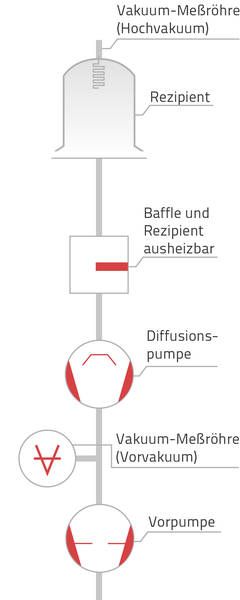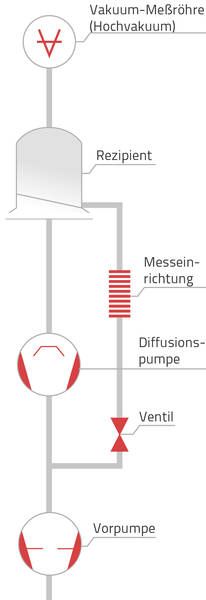OI-808
- Home
- Products
- Consumables
- Oils & Lubricants
- OI-808
Silicone diffusion pump oil

Are you looking for a high-quality diffusion pump oil or a replacement for DC702 / DC704 / DC705, which is no longer available?
We have exactly what you are looking for!
The demands on working with diffusion pumps or to the pump fluids used in those pumps are constantly increasing Compared to purely organic oils (hydro-carbons, esters, etc.), silicone diffusion pump oils have the advantage that they can exhibit high temperature and oxidation resistance. HS-Group Silicone Diffusion Pump Oil (OI-808) has ideal properties and is therefore perfectly suited for use in terms of final vacuum, intake speed, pre-vacuum resistance and backflow rates.
The HS-Group silicone diffusion pump oil OI-808 is characterized in particular by the following properties:
- Suitable for all types of diffusion pumps
- Chemically inert, high thermal stability
- Oxidation resistance
- Radiation resistance
- Moisture resistance
- Steam resistance
- Excellent price/performance ratio
Another advantage is above all the low vapor pressure. In addition, the oil is chemically inert and thus compatible with the materials used in the diffusion pumps (aluminum, chromium, nickel and steel). A high-boiling fraction of phenylmethylsiloxanes forms the chemical structure of the HS-Group silicone diffusion pump oil OI-808. The properties of our oils can be found in the following table.
OI-808 - characteristics
| Silicone Diffusion Pump Oil | OI-808-2 | OI-808-4 | OI-808-5 |
|---|---|---|---|
| Chemical name | Phenylmethyl- dimethylcyclosiloxan mixture |
Tetramethyl- Tetraphenyl- Trisiloxan |
Pentaphenyl- Trimethyl- Trisiloxan |
| Colour | transparent to light yellow |
transparent | transparent |
| Odour | odourless | odourless | odourless |
| State at 25 °C | liquid | liquid | liquid |
| Ultimate pressure untrapped, mbar | up to 10-6 | up to 10-8 | up to 10-9 |
| Ultimate pressure trapped, mbar | n/a | up to 10-10 | up to 10-10 |
| Vapour pressure at 25 °C, mbar | 6 x 10-7 | 2 x 10-8 | 4 x 10-10 |
| Viscosity at 25 °C, mm²/s | 45 | 38.9 | 165 – 185 |
| Density at 25 °C / 10,6 °C, g/cm³ | 1.07 | 1.07 | 1.09 |
| Flash point, °C | 190 | 212 | 243 |
| Boiling point at 0,67 mbar, °C | > 180 | > 215 | > 245 |
| Pour point, °C | < -20 | < -20 | -12 |
| Auto ignition temperature, °C | > 480 | > 480 | > 480 |
| Evaporation heat, kJ/g mol | n/a | 105 / 200 | 117 / 250 |
| Surface tension, mN/m | 30 | 37 | 36 |
| Molecular weight | 530 | 484 | 546 |
| Possible replacement for | DC702, AN20, AN30 | DC704, AN30, AN140, CVC704, VEECO74-SI |
DC705, AN175 |
Final vacuum
The HS-Group Silicone Diffusion Pump Oil OI-808 achieves ultimate vacuums of 10-6 to 10-7 mbar thanks to its low vapor pressure—provided it complies with the regulations of UHV technology (surface-treated parts and metal or Viton seals), and provides adequate heat output and sufficiently low pre-vacuum.
The following vacuum data are based on a test bench designed according to the rules of the UHV technology. The test set-up for the determination of the final vacuum is shown systematically in the adjacent figure. After the baffles and recipient are baked out over several hours, the resulting final pressure is evaluated. The test duration is 24 hours.
When using an ionization vacuum gauge, suitable for high vacuum measurements, the vacuum measurement is carried out. Depending on the design of the pump, the heating power and the method of measurement, the values for the final vacuum range from 10-6 to 10-7 mbar, unless the equipment is baked out and baffles are not used.
If the special baffles are cooled with liquid nitrogen, significantly better values (up to 10-10 mbar) can be achieved.

Permissible vacuum pressure (counterpressure resistance)
The upper limit of the vacuum system—that is to say, the maximum permissible vacuum pressure (counter pressure resistance)—which is still permissible for the operation of a diffusion pump is critical to the requirements. The pre-vacuum of the HS-Group silicone diffusion pump oil OI-808 should be in the range of 10-1 to 10-2 mbar.
In the figure opposite, the schematic setup for measuring the maximum the permissible vacuum pressure is shown. Here, the final pressure on the intake side of the diffusion pump is first measured.
With the aid of the gas metering valve, air is supplied to the pre-vacuum pressure until the high-vacuum collapses in the course of the falling motive steam flow inside the pump. As a rule, the measurements are carried out without gas load and with different heat outputs at the diffusion pump.

Oil backflow
The diffusion pump oil backflow is that amount of oil which enters the high vacuum chamber under the same operating conditions in a certain time unit. Compared to hydrocarbons (organic oils), the HS-Group silicone diffusion pump oil OI-808 is remarkably favorable due to the very narrow molecular weight distribution.
It is remarkable that even after one week of operating the diffusion pump with diffusion pump oil OI-808 and by using a water-cooled baffle, no contaminated quantity could be detected.
The diagram on the right-hand side shows the setup for measuring oil backflow of the diffusion pump.

Pumping speed
In practice, the pumping speed is described by the system flow rate, which is the product of speed and pressure. Significantly, the pumping speed is determined by the design of the diffusion pump and the flow through the system. The pump design sets the speed. However, good pump performance (at a given pressure) is achieved solely by the quality and properties of the oil used.
Oxidation and heat resistance
Thanks to its excellent temperature resistance, the HS-Group silicone diffusion pump oil OI-808 exhibits no cracking effects even at very high operating temperatures. For fast-vented systems without valves, the oxidation resistance of the oil shows its advantages. Even after the collapse of air, no decrease in ultimate vacuum can be detected. Thus, the systems always remain ready and clean. Another advantage is that the cooling and the associated downtimes are very short. Consequently, the working cycles are also shortened. HS-Group Silicone Diffusion Pump Oil OI-808 recovers significantly faster after exposure to air than an organic oil.
Possible applications for silicone diffusion pump oil OI-808
Automotive Industry | Surface sealing Headlight coating Trim panels |
Electrical industry | Manufacture of picture tubes Manufacture of fluorescent tubes Manufacture of light bulbs Contact layers Electrical capacitors |
Plastic industry | Surface improvement Anti reflective coating Protective coatings Film coating |
Metal industry | Zone refining plants Vacuum sintering furnaces Vacuum sintering plants Metal degassing |
Optical industry | Surface improvement Anti reflective coatings Optical filters Mirrors |
Other industry areas | Molecular plants R&D plants Mass spectrometry Particle accelerator |
Compatibility and interchangeability with other diffusion pump oils
Diffusion pump oils are propellants; they are not lubricants. To achieve a good suction and a discharge pressure in addition to a good pump geometry, a very good and strong propellant (pump fluid) is also needed. Very often, the propellant is adapted to the process or the vacuum system. At this point, vacuum equipment manufacturers often bring an economic aspect to the foreground. If, for example the process requires only a vacuum in the range of 10-3 to 10-4 mbar, the manufacturer very often like to select cheaper oils. In UHV (ultrahigh vacuum) systems, however, the higher quality oils are used to achieve the required low ultimate vacuum pressures. HS-Group OI-808-5 is a high-quality oil capable to replace the most common oils that are currently on the market and it is compatible with DC-705 It not only offers higher suction power and better ultimate pressure but also lower oil backflow. Despite these excellent quality features, we have been able to keep the price at a very reasonable level. For this reason, it the oil is now often used as a substitute for DC 704 and DC 702 oil. Of course, we also supply you with the replacement oil suitable for your current oil.
Performance and return guarantee
Contact us and let us know what oil you want to replace or what process you want to run or currently operate. We will be happy to advise you. If your oil is replaceable, as it is true in 99% of all cases, you will receive a performance and return guarantee from us.
Lowest Price Guarantee
If you can prove to us before or up to 3 months after your purchase that a European competitor offers a comparable diffusion pump oil at a lower price per quantity ordered, we will adjust the price for your purchase made.
Diffusion pump description
The diffusion pump is a propellant pump when the suction pressure in the mixing chamber is substantially lower than the static pressure in the propellant jet (vacuum pump). The name comes from the fact that, in the diffusion pump, the mixing of blowing jet and aspirated gas takes place by diffusion of the gas in the beam; while in the other jet pumps this is preferably done in a turbulent boundary layer. The diffusion pump has basically the same function as a steam-jet pump. However, diffusion pumps have a lower heat output and lower operating pressures (between 10-3 mbar and 10-11 mbar). In operation, the heated propellant enters the steam pipes upwards and passes through one or more nozzles when the steam passes the jets with multiple speed of sound and finally hit the pump body It is deflected downward and carries the suctioned gas molecules along. The gas is then pumped out by the backing pump, the condensed propellant is running on the walls of the pump body down, back into the boiling chamber. Today, mostly high molecular weight oils are used as propellant and are based on oil, silicones, or certain esters.

HZ: Heater, SR: Boiler, PG: Pump housing,
K: Water cooling, HF: high vacuum flange,
GM: gas molecules, DS: accelerated oil steam,
VV: pre-vacuum flange, A,B,C,D: jet system,
TD: oil steam from boiler
Home | Contact | Imprint | Privacy Policy | Terms and conditions
2025 © HS-Group GmbH

